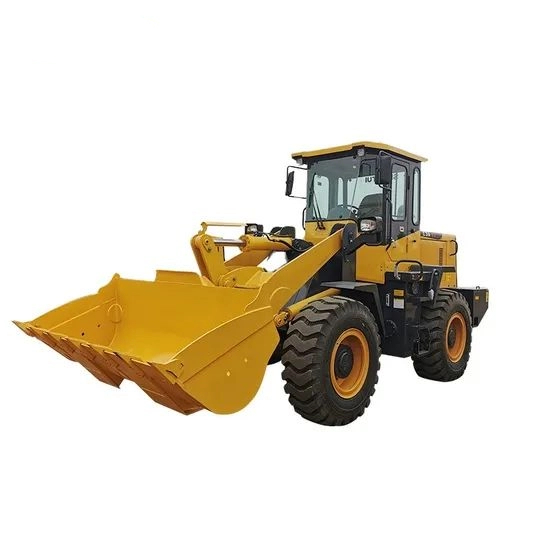When choosing between a wheel loader and an excavator-loader (commonly known as a "two-way machine") for small-tonnage loaders (usually referring to the 1-3 ton class), the decision should be based on the core needs of the operation scenario, functional focus, and frequency of use. The two have significantly different design orientations. The following is a comparative analysis from key dimensions to help you make a more appropriate choice:

I. Comparison of Core Functions and Operation Scenarios
1. Wheel Loader
Core functions: Focusing on loading and handling, it is good at efficiently processing bulk materials (such as sand, soil, and material piles). It completes the "shoveling - transferring - unloading" cycle through the bucket. Some models can be equipped with auxiliary tools such as forks and push plates to expand to stacking and leveling operations.
Advantageous scenarios:
Advantageous scenarios:
- Open spaces (such as small construction sites, farms, and material yards) where frequent short-distance material transfer is required;
- The primary goal is "loading efficiency" with single and repetitive operation contents (such as loading materials into trucks, and site organization);
- Not high requirements for equipment flexibility, but need a relatively fast driving speed (the wheeled design usually has a higher speed than the excavator-loader).
Limitations: It has no excavation function. When encountering scenarios that require trenching, foundation pit digging, crushing hard soil, etc., an additional excavator is needed, which increases the equipment cost.
2. Excavator-Loader (Two-way Machine)
Core functions: Integrating loading and excavation, with a loader bucket at the front and an excavator arm + bucket at the rear. It can quickly switch operation modes and achieve multi-functional operations by replacing auxiliary tools (such as breakers, grapples, and drills).
Advantageous scenarios:
Advantageous scenarios:
- Complex and diverse operation contents that require both material loading and excavation (such as small municipal maintenance, rural construction, simultaneous site leveling and trenching);
- Limited space where it is inconvenient to park both a loader and an excavator at the same time (such as narrow construction sites, and factory areas);
- Limited budget and hope to "use one machine for multiple purposes" to reduce equipment investment, especially suitable for small and medium-sized engineering teams or individual users.
Limitations: - The loading efficiency is slightly lower than that of pure wheel loaders of the same tonnage (due to the limitation of the body balance design, the bucket capacity is usually slightly smaller and the operation speed is slightly slower);
- The excavation performance is weaker than that of professional excavators of the same tonnage (the arm length and excavation depth are limited, so it is not suitable for heavy excavation operations).
II. Comparison of Performance and Practicality
| Dimension | Wheel Loader | Excavator-Loader (Two-way Machine) |
|---|---|---|
| Operation Efficiency | High loading efficiency and fast continuous operation speed | Slightly lower loading efficiency, but saves equipment switching time, with more flexible overall efficiency |
| Functional Diversity | Single (mainly for loading, with limited expansion of auxiliary tools) | Diverse (loading + excavation + multiple auxiliary tools, suitable for complex scenarios) |
| Operation Complexity | Simple, easy for beginners to get started | Slightly complex, requiring mastery of both loading and excavation operation skills |
| Passability | Wheeled design, smooth driving on hard ground, easy to slip on soft ground | Some models can be equipped with four-wheel drive, with better passability than ordinary wheel loaders but not as good as tracked equipment |
| Maintenance Cost | Simple structure, convenient maintenance, low cost | More complex structure (dual working devices + hydraulic system), slightly higher maintenance cost |
| Equipment Price | Cheaper for the same tonnage (about 10%-20% lower) | Higher price, but saves the cost of purchasing an excavator separately |
III. Purchase Suggestions
Situations where a wheel loader is preferred:
- The operation is mainly "pure loading" (such as loading materials in a material yard, transferring feed on a farm), and there is almost no need for excavation functions;
- Pursuing extreme loading efficiency and needing to handle a large amount of materials every day;
- Limited budget, and already having an excavator or no need for excavation operations.
Situations where an excavator-loader is preferred:
- Both "loading" and "excavation" needs exist in the operation (such as needing to level the road surface and dig side ditches when building roads);
- The equipment needs to be used in multiple scenarios (such as loading materials usually, and occasionally digging foundations and crushing concrete);
- The site is narrow, making it inconvenient for multiple devices to collaborate, or hoping to reduce the number of equipment to lower management costs.
Summary
Wheel loaders are "specialized" equipment, suitable for single loading scenarios, pursuing efficiency and low cost; excavator-loaders are "all-round" equipment, suitable for multi-scenario composite operations, exchanging slightly higher costs for functional diversity. Users of small-tonnage models are mostly small and medium-sized users. If the operation needs are not single, the "one machine for multiple purposes" feature of excavator-loaders can often bring higher cost performance; if the needs are extremely single, wheel loaders are more cost-effective.





